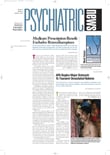Nature photographs in the consulting room of Jon Meyer, M.D., include closeups and panoramic views, leaves, and landscapes.
An avid photographer whose work commands gallery shows, Meyer now serves as president of the American Psychoanalytic Association (APsaA). In a recent talk with Psychiatric News, the Baltimore psychiatrist and psychoanalyst provided a “big picture” view of APsaA's current concerns and long-term goals.
At the grass-roots level, Meyer said, APsaA steps in to aid its members when local health insurers threaten patient privacy, make unsupportable intimations of fraud, or deny reimbursement for analytic treatment, alleging lack of proof of medical necessity.
In Washington, D.C., for example, a model mental health law provides“ extraordinary” protections for patients' privacy, Meyer said. Nonetheless, he continued, insurers have sought access to information on diagnosis, prognosis, progress, treatment plans, and other patient material that APsaA believed would breech its standards of confidentiality.
At meetings brokered by the district's insurance commissioner, Meyer said, APsaA and insurance industry representatives are working to develop guidelines specifying the types of information that can be released. APsaA's efforts, he said, aim to keep the District of Columbia's model statute from being watered down. The satisfactory resolution, he suggested, will hold implications for state legislatures and other insurance carriers nationwide.
APsaA faced a similar challenge in New York, where Oxford Health Plans Inc., a large insurer in that area, had deemed many psychotherapy patient records inadequate and sought repayment of fees. That action threatened the reputations and livelihood of APsaA's 650 New York members, Meyer said. APsaA joined the New York State Psychiatric Association, APA, and other organizations to confront Oxford.
To date, a preliminary agreement that both sides have reviewed defines mutually acceptable standards for clinical record documentation by psychiatrists, psychologists, and social workers who treat Oxford subscribers for documentation review by Oxford. Oxford has agreed to require only reporting of operations performed by the clinician—“interpreted, clarified, consulted, prescribed,” for example—and not those of the patient, said Meyer. Oxford also has agreed to assume responsibility for getting contemporaneous, informed consent from the patients if the insurer needs more information.
On a broader scale, APsaA is among a group of 19 professional, consumer, and advocacy organizations and individuals suing the U.S. Department of Health and Human Services. The group contends that the Health Insurance Portability and Accountability Act of 1996, as currently promulgated, gives away patients' medical information without patients' authorization.
“Since privacy and confidentiality are absolutely central to the psychoanalytic process and its effectiveness,” Meyer said, “we have to take a stand on this issue.”
As a long-term goal, Meyer said, APsaA seeks to expand access to psychodynamic treatment. “We don't want to lose a generation of people who could benefit from this type of therapy to the vagaries of managed care,” he said. Community-based clinics, he suggested, could provide affordable alternatives to managed care.
Meyer ran a community clinic in Milwaukee of the type he envisions nationwide. It was affiliated with the Medical College of Wisconsin, where Meyer served as director of the divisions of psychoanalysis and psychotherapy and of mental health services for 20 years. He retired from those positions earlier this year, before returning to Baltimore, his previous home.
Psychiatry residents staffed the Milwaukee clinic, and members of the Wisconsin Psychoanalytic Society and Institute supervised their work. The clinic used a sliding-fee scale that allowed people to pay out of pocket, Meyer said, yet stay in the black. “Psychoanalysis does not break the bank,” he asserted. “For those who need it, it does what nothing else will do.”
Similar clinics now exist in Pittsburgh, Detroit, and New York City, Meyer said. Five states, however, have no APsaA members.
Increasing the nation's pool of psychoanalysts thus represents another key goal for APsaA, Meyer said. Because many physicians incur large debts for their professional education, aspiring psychoanalysts often defer analytic training. At the Washington, D.C., psychoanalytic institute, each training analyst takes on at least one low-fee payer, he said, making earlier training more affordable.
Young analysts are in short supply: more than 75 percent of APsaA's 3,600 members are aged 50 and older. By comparison, 53 percent of APA members fall into that age group.
Educating the general public about the process of psychodynamic treatment and its benefits, Meyer said, will help drive demand for it. “We have a fabulous product,” he said, but many people believe their mental problems stem from a biochemical imbalance in the brain that medication can fix, or that adjusting thinking in a formulaic manner can bring about change.”
Such tactics may prove insufficient, he suggested, “yet we haven't offered an alternative.”
A private practitioner, Meyer also works part time in a Baltimore community clinic affiliated with the Johns Hopkins University School of Medicine, where he is an associate professor of psychiatry.
Many clinic patients spend hours riding a bus to get to their therapy appointments, he said. Their diligence underscores the importance of meaningful human interaction, he asserted, even in a context of medication management.
Meyer relishes the challenges of his two-year term in office. “The president of APsaA does not sit back and think deep thoughts about psychoanalysis,” he said. “He or she has to be willing to talk to insurance commissioners, medical directors of insurance agencies, bureaucratic regulators, congressmen, and others, to go outside the consulting room to speak up on behalf of the patient.” ▪

